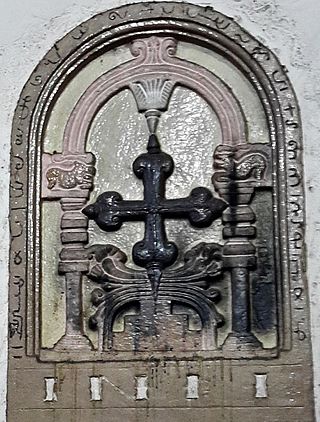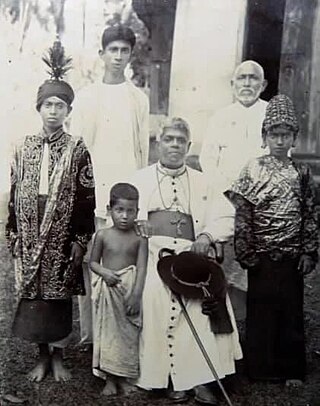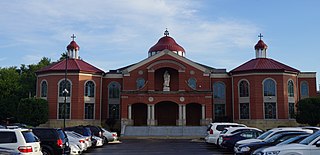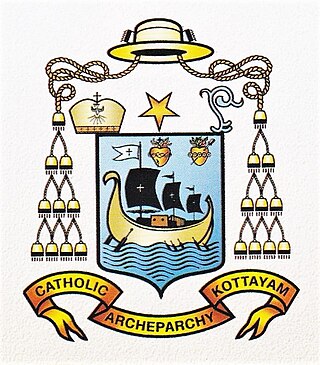Related Research Articles

The Malankara Orthodox Syrian Church (MOSC) also known as the Indian Orthodox Church (IOC) or simply as the Malankara Church, is autocephalous, headquartered in Devalokam, near Kottayam, India. The church serves India's Saint Thomas Christian population. According to tradition, these communities originated in the missions of Thomas the Apostle in the 1st century. It employs the Malankara Rite, an Indian form of the West Syriac liturgical rite.

The Saint Thomas Christians, also called Syrian Christians of India, Marthoma Suriyani Nasrani, Malankara Nasrani, or Nasrani Mappila, are an ethno-religious community of Indian Christians in the state of Kerala, who, for the most part, employ the Eastern and Western liturgical rites of Syriac Christianity. They trace their origins to the evangelistic activity of Thomas the Apostle in the 1st century. The Saint Thomas Christians had been historically a part of the hierarchy of the Church of the East but are now divided into several different Eastern Catholic, Oriental Orthodox, Protestant, and independent bodies, each with their own liturgies and traditions. They are Keralites and speak Malayalam. Nasrani or Nazarene is a Syriac term for Christians, who were among the first converts to Christianity in the Near East.

The Syro-Malankara Catholic Church, also known as the Malankara Syrian Catholic Church, is an Eastern Catholic sui iuris particular church in full communion with the worldwide Catholic Church possessing self-governance under the Code of Canons of the Eastern Churches. It is one of the major archiepiscopal churches of the Catholic Church. It is headed by Major Archbishop Baselios Cardinal Cleemis Catholicos of the Major Archdiocese of Trivandrum based in Kerala, India. With more than 1096 parishes, its one of India's biggest church evangelical establishments.

The Syro-Malabar Church, also known as the Syro-Malabar Catholic Church, is an Eastern Catholic Church based in Kerala, India. It is a sui iuris (autonomous) particular Church in full communion with the Pope and the worldwide Catholic Church, including the Latin Church and the 22 other Eastern Catholic Churches, with self-governance under the Code of Canons of the Eastern Churches (CCEO). The Church is headed by the Major Archbishop of the Syro-Malabar, Raphael Thattil. The Syro-Malabar Synod of Bishops canonically convoked and presided over by the Major Archbishop constitutes the supreme authority of the Church. The Major Archiepiscopal Curia of the Church is based in Kakkanad, Kochi. Syro-Malabar is a prefix reflecting the church's use of the East Syriac Rite liturgy and origins in Malabar. The name has been in usage in official Vatican documents since the nineteenth century.

The Malankara Mar Thoma Syrian Church, often shortened to Mar Thoma Church, and known also as the Reformed Syrian Church and the Mar Thoma Syrian Church of Malabar, is an autonomous Oriental Protestant Christian church based in Kerala, India. While continuing many of the Syriac high church practices, the church is Protestant in its theology and doctrines. It employs a reformed variant of the West Syriac Rite Divine Liturgy of Saint James, translated to Malayalam.

The K'nānāya, also known as the Southists or Tekkumbhagar, are an endogamous ethnic group found among the Saint Thomas Christian community of Kerala, India. They are differentiated from another part of the community, known in this context as the Northists (Vaddakkumbhagar). There are about 300,000 Knanaya in India and elsewhere.

The Eparchy of St. Thomas Syro-Malabar Catholic of Chicago, also known as the St. Thomas Syro-Malabar Diocese of Chicago, is a Syro-Malabar Catholic Church ecclesiastical territory or eparchy of the Catholic Church in the United States. Its episcopal seat is the Mar Thoma Sleeha Cathedral in the episcopal see of Chicago in Illinois state.

The Syro-Malabar Catholic Archeparchy of Kottayam is a metropolitan Archeparchy of the Syro-Malabar Catholic Church in India. The Archeparchy is exclusively for Knanaya faithful who are the descendants of Syriac Judeo-Christians who migrated from South Mesopotamia to Kodungallur (Muziris) in South India in 4th century.

This article lists the various old and ancient churches that exist among the Saint Thomas Christians in Kerala.

Thomas of Cana was a Syrian Christian merchant magnate who arrived to the Chera Dynasties capital city of Kodungallur between 345 C.E. and 811 C.E. Thoma brought with him Jewish-Christian families and clergymen from Persian Mesopotamia.

The Jacobite Syrian Church, or the Syriac Orthodox Church in India, is a Maphrianate of the Syriac Orthodox Church of Antioch based in Kerala, India and part of the Oriental Orthodox Church. It recognizes the Syriac Orthodox patriarch of Antioch and All the East as supreme head of the church. It functions autonomously within the church as an Archdiocese, administered by the Metropolitan Trustee, under the authority of the Maphrian of India, Baselios Thomas I. Following schism with the Malankara Orthodox Syrian Church, is currently the only church in Malankara that is under the administrative supervision of Syriac Orthodox Church. The church employs the West Syriac Rite Liturgy of Saint James.

The Malankara Church, also known as Puthenkur, is the historic unified body of West Syriac Saint Thomas Christian denominations which claim ultimate origins from the missions of Thomas the Apostle. This community, under the leadership of Thoma I, opposed the Padroado Jesuits as well as the Propaganda Carmelites of the Latin Church, following the historical Coonan Cross Oath of 1653. The Malankara Church's divisions and branchings have resulted in present-day Churches that include the Jacobite Syrian Christian Church, the Malankara Orthodox Syrian Church, the Malankara Mar Thoma Syrian Church, the Malabar Independent Syrian Church, the Syro-Malankara Catholic Church, the Saint Thomas Anglicans of the Church of South India and the St. Thomas Evangelical Church of India.
The Malankara Rite is the form of the West Syriac liturgical rite practiced by several churches of the Saint Thomas Christian community in Kerala, India. West Syriac liturgy was brought to India by the Syriac Orthodox Bishop of Jerusalem, Gregorios Abdal Jaleel, in 1665; in the following decades the Malankara Rite emerged as the liturgy of the Malankara Church, one of the two churches that evolved from the split in the Saint Thomas Christian community in the 17th century. Today it is practiced by the various churches that descend from the Malankara Church, namely the Malankara Mar Thoma Syrian Church, Malankara Orthodox Syrian Church, the Jacobite Syrian Christian Church, the Syro-Malankara Catholic Church and the Malabar Independent Syrian Church.

The Saint Thomas Christian denominations are Christian denominations from Kerala, India, which traditionally trace their ultimate origins to the evangelistic activity of Thomas the Apostle in the 1st century. They are also known as "Nasranis" as well. The Syriac term "Nasrani" is still used by St. Thomas Christians in Kerala. It is part of the Eastern Christianity institution.

Several historical evidences shed light on a significant Malankara–Persian ecclesiastical relationship that spanned centuries. While an ecclesiastical relationship existed between the Saint Thomas Christians of India and the Church in Sassanid Empire in the earlier centuries, closer ecclesiastical ties developed as early as seventh century, when India became an ecclesiastical province of the Church of the East, albeit restricted to matters of purely ecclesiastical nature such as ordination of priests, and not involved in matters of temporal administration. This relationship endured until the Portuguese protectorate of Cochin of Malabar came to be in 16th century, and the Portuguese discovery of a sea route to India. The Christians who came under the two ancient yet distinct lineages of Malankara and Persia had one factor in common: their Saint Thomas heritage. The Church of the East shared communion with the Great Church until the Council of Ephesus in the 5th century, separating primarily over differences in Christology.
Reflecting the religious constitution of the population, a large number of Hindu temples and Christian churches dot the townscape of Kottayam district. Some of them are the Thirunakkara Mahadeva temple, Kumaranalloor Devi temple, Thiruvarrpu Sri Krishna Temple, Thaliyil Mahadeva Temple, Pallippurathukavu Bhagavathi Temple, Elia Cathedral, Kottayam Valiya Pally, Manarcad Cathedral, Cheriya Palli, CSI Holy Trinity cathedral, Puthuppally St. George Church and Thazhathangadi Juma Masjid. All the temples of Kottayam were also built under royal patronage of Hinduism during the 2nd millennium.
According to the 2011 census Kottayam district has a population of 1,979,384, This gives it a ranking of 234th in India. The district has a population density of 896 inhabitants per square kilometre (2,320/sq mi). Its population growth rate over the decade 2001–11 was 1.32%. Kottayam has a sex ratio of 1040 females for every 1000 males, and a literacy rate of 96.4%.

The Paḻayakūṟ, also known as Romo-Syrians or Syrian Catholics of Malabar, are the East Syriac denominations of the Saint Thomas Christian Church, which claim ultimate apostolic origin from the Indian mission of Thomas the Apostle in the 1st century AD.
References
- ↑ "Valiyapally". www.valiyapallyranni.com.
- ↑ "Knanaya Samudayam". knanayaarchdiocese.com.
- ↑ "Syriac Orthodox (Jacobite) Churches in India". www.syriacchristianity.info.
- ↑ Williams, Raymond Brady; Brady, Williams Raymond. Christian Pluralism in the United States: The Indian Immigrant Experience. Cambridge University Press. ISBN 978-0-521-57016-9.
